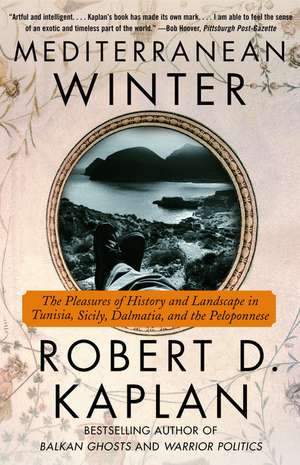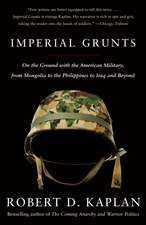Mediterranean Winter: The Pleasures of History and Landscape in Tunisia, Sicily, Dalmatia, and the Peloponnese
Autor Robert D. Kaplanen Limba Engleză Paperback – 28 feb 2005
— Bob Hoover, Pittsburg Post-Gazette
“[Kaplan] helps the distant past resonate today. . . . [He] teaches lessons that are informative and concise.” –The Washington Post Book World
“A writer of extraordinary intellect and passion . . . with a wonderfully lucid way of relating history as a living thing.” –San Francisco Chronicle
“Erudite and intrepid. . . . [Kaplan] is a deft guide to wherever he chooses to lead you.” –The New York Times
Preț: 100.57 lei
Nou
Puncte Express: 151
Preț estimativ în valută:
19.24€ • 20.15$ • 15.92£
19.24€ • 20.15$ • 15.92£
Carte disponibilă
Livrare economică 15-29 martie
Preluare comenzi: 021 569.72.76
Specificații
ISBN-13: 9780375714337
ISBN-10: 0375714332
Pagini: 254
Ilustrații: 1 MAP
Dimensiuni: 135 x 203 x 15 mm
Greutate: 0.21 kg
Editura: Vintage Books USA
ISBN-10: 0375714332
Pagini: 254
Ilustrații: 1 MAP
Dimensiuni: 135 x 203 x 15 mm
Greutate: 0.21 kg
Editura: Vintage Books USA
Extras
The Tigress
Divinity exists in beautiful memories: leaves like weightless bronze, engraved with the year, falling amid the trees of Rodin's sculpture garden in Paris. For Rodin, the human body was the ultimate expression of nature, and nudity the opposite of decadence because it bore the glory and pain of the universe. Inside the artist's mansion, I recall torsos that, as Rainer Maria Rilke writes, were complete even though they lacked arms, and a haggard woman with a sagging belly and crumpled breasts who was beautiful. Rodin knew that limbs and youth are superfluous to beauty. Rodin's "Old Woman" is the true goddess of travel. Her body is the tortured ruin of a lifetime, whose memories are intimated by her downward gaze. Her knowledge and experience now have no material purpose except reflection. Indeed, the sculpture may represent a courtesan brooding over her sins: travel is where we truly meet ourselves. We remember what we must in order to endure, says the philosopher Henri Bergson. That is why so much of commonplace existence is forgotten, while our journeys never are.
"The masses do not see the Sirens," Nikos Kazantzakis observes. "They do not hear songs in the air. Blind, deaf, stooping, they pull at their oars in the hold of the earth. But the more select, the captains, harken to a Siren within them...and royally squander their lives with her." Kazantzakis' siren is a "merciless voice-the TIGRESS." She is his companion on all his journeys. She "digs her claws into my brain, and we reflect on all we have seen and all we have yet to see." Robert Graves calls her the "White Goddess," who can appear as a "she-wolf, tigress, mermaid or loathsome hag." The test of any writer's vision, Graves says, is "the accuracy of his portrayal" of her. The goddess's physical beauty lies only in her eyes. Her allure is the life of the mind. For it is the yearning after comparisons and metaphors for each new object and landscape that sanctifies consciousness.
Leaves falling on statues were my last memory of autumn for fourteen years. That evening I boarded a train south to Marseilles and instantly consigned Rodin's garden to the past. Like all diarists, I wrote down what I felt before moving on, while the mood of the place still dominated my thoughts. Now I travel in retrospect: excavating only the most useful fragments. Thus, I will keep personal matters to a minimum. I had recently graduated from college and was working at a small newspaper in Vermont. In the summer of 1975, I watched the civil war in Lebanon on the nightly news. In the hope of becoming a foreign correspondent, I applied for a job at the wire services, the television networks, and over a dozen large metropolitan newspapers. With little experience as a journalist and a degree from a middle-of-the-pack college, my resume was forgettable. No one hired me. I was restless. My father, a truck driver, had spent his twenties riding railway cars around the United States, earning a living as a horse-racing tout in forty-three of the lower forty-eight states. After a "big score" he would check into a first-class hotel, a big cigar in hand: twenty-four hours later he would be living a hobo's existence like so many others in the 1930s. He filled me with stories of his escapades in Depression-era America, and of the conquering image of a still-pastoral and naive nation, where the scams he ran were relatively innocent and people bought you a meal when you were down and out. My father's last memory of travel was in 1942. He had just completed basic training in Fort Polk, Louisiana, and was heading north on a troop train for dispatch to Europe. At a rail junction near Cairo, Illinois, the sun was setting in rich colors over the prairie. Other trains were then converging from several tracks onto a single line that would take the soldiers to points along the East Coast where ships awaited. Across a wide arc, all he saw were trains and more trains, with soldiers looking out through every window as each train curved toward the other against a flat and limitless landscape lit red by the sun. I had a traveling companion. Though we shared an intimacy that gave the journey its own enchantment, on another plane we remained two solitary beings filling up the pages of our respective notebooks. What follows is a record of that second, silent plane of existence, where the pronoun I is more appropriate than we. I wandered through landscapes as though down the corridors of a museum, groping toward a vocation that I had never found in college. Because I now know much more about these places than when I first saw them, my recollection cannot help but be both enhanced and distorted.
Rilke writes that the Greek and Roman galleries in the Louvre "revealed to Rodin radiant visions of an antique world of southern skies, a sea, heavy stone monuments from immemorial civilizations." Rodin had not simply copied the Greek and Roman style. He was heir to two millennia of Christian culture. His statues owe their powerful effect to the turmoil and agitation arising from the guilt of original sin. Thus, they lack the idealized serenity common to classical sculpture. I remember them because of their link to the ancient ruins and medieval churches that I saw afterwards in Tunisia and Sicily: places that drew me because of the books I read. For those who, in Kazantzakis' words, "squander their lives" with the Tigress, the great events of life come from the books, rather than the people, one comes across. Some books show us a new world, others vindicate our own experience. Books can lead you astray, they can ruin you, they can deliver you from the strictures of your environment. Because some are so important one remembers perfectly the circumstances in which one found them, and read them. You don't find the books that change your life by accident; nor by design. One finds them the way a ragpicker finds something useful in the garbage, or the way a hunter accidentally encounters his prey. The enterprise demands vigilance, says the philosopher Walter Benjamin: it takes practice to lose one's way in a city in order to discover something important about it. I had strayed into a bookshop in Hanover, New Hampshire, on an October day of intense sunlight and broken shadows, melancholy despite the electric colors of the leaves. On a back shelf I found Gustave Flaubert's Salammbo and Michel Zeraffa's Tunisia; on a table near the front of the shop was Livy's The War with Hannibal. Henceforth, I encountered civilizations and empires: Numidian, Roman, and Carthaginian; Vandal and Byzantine; Aghlabid, Zirid, and Hafsid. Also kings, generals, saints, false prophets, and wise men: Jugurtha, Scipio Africanus, Hannibal, Genseric, St. Augustine, Donatus, Justinian, Ibn Khaldun. In Salammbo, Flaubert writes of a war between Carthage and its Libyan-led mercenaries, who rebelled in 241 B.C. His chilling descriptions of an organized state defending itself against an anarchic horde made a lasting impression on me. In Flaubert's hands, Tunisia became a land of monsters and ruins, blood and sensuality. He depicts mercenaries painted with vermilion "like coral statues"; soldiers snoring "open-mouthed" beside the burnt corpses of monkeys; lions crucified along a road; barbarians smearing butter and cinnamon on the faces of idols in celebration of a victory; and the sacrifice of children to appease the pagan god Baal. When the Carthaginian priestess Salammbo finds a Libyan mercenary leader alone in his tent, her body smells of "honey, pepper, incense, and roses," while the stench of nearby elephants wafts through a tear in the canvas. Flaubert's description of the effects of a thunderstorm upon a crowd, prior to the ritual slaughter of boys, provides a rare insight into the emotions behind child sacrifice. The war that Livy records between Rome and Carthage occurred two decades after the one described by Flaubert. While many of the battles were fought in Sicily, the war climaxed in Tunisia. For millennia, Tunisia, with its command of the Sicilian Channel, guarded the whole of the western Mediterranean. That autumn I pored over maps of Tunisia and Sicily: two inviting fragments of land, with deserts, almond-clad mountains, and ruins. Their volatile inhabitants had embraced Christianity, the Donatist heresy, and Islam with equal passion. The two territories form the bottleneck of the Mediterranean, dividing it into east and west: each, as I would learn, with its own historical and cultural pattern. I would fly to France and take a boat to Tunisia, with the aim of traveling about the Mediterranean. The winter stretched ahead of me like a lifetime. How to recapture the sense of endless possibilities before the accumulation of deeds to justify: when one was unaccountable to time because there was always time to make up for a mistake?
On an icy midnight in November 1975 I boarded a train at the Gare de Lyon in Paris bound for Marseilles. At dawn, I awoke near Arles to the sting of salt air and olive trees against a soft sky the color of pressed grapes. Shaved rolling fields of the deepest vegetal green, immaculately sectioned by poplars, had dissolved into the confusion of sandy hillsides and sagging roofs of moldering clay. Northern Europe had vanished. I had $1,000 in traveler's checks and no return ticket. I had left the newspaper in Vermont and would never hold another job. Like so many other free-lance journalists I would meet over the years, I was never to enjoy the social and professional status-or the generous travel budgets-of foreign correspondents for major media organizations. I read and studied on my own and sold articles to newspapers, which provided me just enough money to get by in youth hostels and cheap hotels, and to continue traveling. Innovate was the creed I was forced to adopt. Without money for transatlantic calls and before the era of fax machines and courier services, I relied on local post offices, where I found acceptance letters or rejection slips, checks or returned articles. My choices were driven by the contingencies of the moment. It was a life of radical freedom. After the crowds and commotion of Marseilles' Saint Charles station, I tumbled straight into the city: down the station's steep marble staircase with its panoramic view of crowded thoroughfares that lead to the Old Port. Amid cheap department stores and plate-glass kiosks, where dark men in ski caps bought snacks labeled halal-"fit for Moslems"-I smelled garbage and the chilly breath of the Mediterranean for the first time. The wind blew under a leaden roof of clouds. I felt as cold as in Paris, and heard Arabic and French fired in staccato bursts like Italian. Trucks were unloading crates of fish and produce. I entered an unlit bar for a cup of coffee. Tables were stacked in the back. Broken, dusty mirrors were graced by art nouveau friezes. A pinball machine stood in the corner, where men gossiped and filled out lotto tickets. I found a hotel for the equivalent of four dollars: a faded yellow room with damp floors and exposed pipes. It stood on a narrow street of pizza joints where Arab men sold cheap watches and colognes in metal stalls. Paris had been a clutter of gilded mirrors and perfectly arranged shops, a dense quilt of museums and cobblestones on certain streets. Marseilles felt like a raw wind, stripping away formalities and traditions, the vacuum filled by hustling, working-class Arab immigrants. Marseilles' rough edge was its seduction. It "perspires in the sun like a beautiful girl who does not take good care of herself," wrote Maupassant in the nineteenth century. Marseilles was rogue waiters, plastic chairs, vinyl table cloths, and the smells of steaming mullet and eel. Life here was lived in the open: less attention was paid to interiors and their details. Greek sailors from Phocaea, on the coast of Asia Minor, had founded Marseilles in 600 B.C., attracted by its deep harbor protected on all sides by an amphitheater of hills. Massalia is Phoenician for "settlement," so perhaps the Phoenicians had arrived here first. Greek Massalia threatened Phoenician Carthage's zone of influence. Montesquieu writes of "great wars between Carthage and Marseilles over fishing grounds." The Greeks, though imperiled by surrounding Roman colonies in Gaul, nevertheless allied themselves with Rome against Carthage. Montesquieu goes on: The war the Romans waged against the Carthaginians in Spain was a source of wealth for Marseilles, which served as their storehouse. The ruin of Carthage and Corinth increased further the wealth of Marseilles; and, if it had not been for the civil wars in which one had blindly to choose a party, it would have been happy under the protection of the Romans, who were not jealous of its commerce. Marseilles taught me that Mediterranean history was about power first, beauty second. The artistic monuments I had seen in the Louvre were the products of wealthy empires that mastered the hurly-burly of commerce and military strategy before they could produce great art. Except for what the French scholar Fernand Braudel calls "the leveling hegemony of Rome" (following its final defeat of Carthage in 146 b.c.), the Mediterranean throughout antiquity and the Middle Ages had been a stern document of balance-of-power politics. The poverty of its sandy soil had forced the peoples of the region to go abroad for conquest, yet neither the Carthaginians nor the Greeks, the Vandals, the Byzantines, the Venetians, or the Turks could control the entire sea. The city before me was a replica of that turbulent history: Arabs from North Africa, Italians, Spaniards, Greeks, Corsicans, and other immigrants had drifted to its unkempt streets, the human detritus of upheavals and trading ties, making Marseilles the most Mediterranean of cities. In the spirit of ancient Phocaea, whose founding city Tacitus had described as equally crass, Marseilles was dedicated to mercantilism and had few public monuments. Those that there were reflected the needs of a population consumed with economic survival. The two nineteenth-century churches were heavy in style, their gloomy splendor exuding strength, not grace. Their interiors were jammed with ex-votos, for it was the promise of miracles that gave people the strength to face the next day. La Major (Sainte-Marie-Majeure) was a mock-Byzantine pile. It sat by the harbor near the site of a pagan temple dedicated to Diana. Notre Dame de la Garde was perched on an outcrop overlooking the city, its gilded statue of the Virgin visible from all points like a giant good luck charm. La Canebiere, the principal thoroughfare, was lined with cheap luggage and toy stores. Its name came from the Latin cannabis, an allusion to a rope-making factory that had existed nearby. I followed it to the Old Port, settled more than 2,500 years ago by Phocaean Greek sailors-a vast, rectangular sweep of oily-gray water bordered by peeling shuttered apartment buildings. I was pelted by rain and had no umbrella. One drop chased another so quickly that the sea water looked encrusted by rough glass. On the slippery esplanade, people in soggy work clothes queued for slabs of bass and mini-mountains of oysters under canvas awnings slapping loudly in the wind.
From the Hardcover edition.
Divinity exists in beautiful memories: leaves like weightless bronze, engraved with the year, falling amid the trees of Rodin's sculpture garden in Paris. For Rodin, the human body was the ultimate expression of nature, and nudity the opposite of decadence because it bore the glory and pain of the universe. Inside the artist's mansion, I recall torsos that, as Rainer Maria Rilke writes, were complete even though they lacked arms, and a haggard woman with a sagging belly and crumpled breasts who was beautiful. Rodin knew that limbs and youth are superfluous to beauty. Rodin's "Old Woman" is the true goddess of travel. Her body is the tortured ruin of a lifetime, whose memories are intimated by her downward gaze. Her knowledge and experience now have no material purpose except reflection. Indeed, the sculpture may represent a courtesan brooding over her sins: travel is where we truly meet ourselves. We remember what we must in order to endure, says the philosopher Henri Bergson. That is why so much of commonplace existence is forgotten, while our journeys never are.
"The masses do not see the Sirens," Nikos Kazantzakis observes. "They do not hear songs in the air. Blind, deaf, stooping, they pull at their oars in the hold of the earth. But the more select, the captains, harken to a Siren within them...and royally squander their lives with her." Kazantzakis' siren is a "merciless voice-the TIGRESS." She is his companion on all his journeys. She "digs her claws into my brain, and we reflect on all we have seen and all we have yet to see." Robert Graves calls her the "White Goddess," who can appear as a "she-wolf, tigress, mermaid or loathsome hag." The test of any writer's vision, Graves says, is "the accuracy of his portrayal" of her. The goddess's physical beauty lies only in her eyes. Her allure is the life of the mind. For it is the yearning after comparisons and metaphors for each new object and landscape that sanctifies consciousness.
Leaves falling on statues were my last memory of autumn for fourteen years. That evening I boarded a train south to Marseilles and instantly consigned Rodin's garden to the past. Like all diarists, I wrote down what I felt before moving on, while the mood of the place still dominated my thoughts. Now I travel in retrospect: excavating only the most useful fragments. Thus, I will keep personal matters to a minimum. I had recently graduated from college and was working at a small newspaper in Vermont. In the summer of 1975, I watched the civil war in Lebanon on the nightly news. In the hope of becoming a foreign correspondent, I applied for a job at the wire services, the television networks, and over a dozen large metropolitan newspapers. With little experience as a journalist and a degree from a middle-of-the-pack college, my resume was forgettable. No one hired me. I was restless. My father, a truck driver, had spent his twenties riding railway cars around the United States, earning a living as a horse-racing tout in forty-three of the lower forty-eight states. After a "big score" he would check into a first-class hotel, a big cigar in hand: twenty-four hours later he would be living a hobo's existence like so many others in the 1930s. He filled me with stories of his escapades in Depression-era America, and of the conquering image of a still-pastoral and naive nation, where the scams he ran were relatively innocent and people bought you a meal when you were down and out. My father's last memory of travel was in 1942. He had just completed basic training in Fort Polk, Louisiana, and was heading north on a troop train for dispatch to Europe. At a rail junction near Cairo, Illinois, the sun was setting in rich colors over the prairie. Other trains were then converging from several tracks onto a single line that would take the soldiers to points along the East Coast where ships awaited. Across a wide arc, all he saw were trains and more trains, with soldiers looking out through every window as each train curved toward the other against a flat and limitless landscape lit red by the sun. I had a traveling companion. Though we shared an intimacy that gave the journey its own enchantment, on another plane we remained two solitary beings filling up the pages of our respective notebooks. What follows is a record of that second, silent plane of existence, where the pronoun I is more appropriate than we. I wandered through landscapes as though down the corridors of a museum, groping toward a vocation that I had never found in college. Because I now know much more about these places than when I first saw them, my recollection cannot help but be both enhanced and distorted.
Rilke writes that the Greek and Roman galleries in the Louvre "revealed to Rodin radiant visions of an antique world of southern skies, a sea, heavy stone monuments from immemorial civilizations." Rodin had not simply copied the Greek and Roman style. He was heir to two millennia of Christian culture. His statues owe their powerful effect to the turmoil and agitation arising from the guilt of original sin. Thus, they lack the idealized serenity common to classical sculpture. I remember them because of their link to the ancient ruins and medieval churches that I saw afterwards in Tunisia and Sicily: places that drew me because of the books I read. For those who, in Kazantzakis' words, "squander their lives" with the Tigress, the great events of life come from the books, rather than the people, one comes across. Some books show us a new world, others vindicate our own experience. Books can lead you astray, they can ruin you, they can deliver you from the strictures of your environment. Because some are so important one remembers perfectly the circumstances in which one found them, and read them. You don't find the books that change your life by accident; nor by design. One finds them the way a ragpicker finds something useful in the garbage, or the way a hunter accidentally encounters his prey. The enterprise demands vigilance, says the philosopher Walter Benjamin: it takes practice to lose one's way in a city in order to discover something important about it. I had strayed into a bookshop in Hanover, New Hampshire, on an October day of intense sunlight and broken shadows, melancholy despite the electric colors of the leaves. On a back shelf I found Gustave Flaubert's Salammbo and Michel Zeraffa's Tunisia; on a table near the front of the shop was Livy's The War with Hannibal. Henceforth, I encountered civilizations and empires: Numidian, Roman, and Carthaginian; Vandal and Byzantine; Aghlabid, Zirid, and Hafsid. Also kings, generals, saints, false prophets, and wise men: Jugurtha, Scipio Africanus, Hannibal, Genseric, St. Augustine, Donatus, Justinian, Ibn Khaldun. In Salammbo, Flaubert writes of a war between Carthage and its Libyan-led mercenaries, who rebelled in 241 B.C. His chilling descriptions of an organized state defending itself against an anarchic horde made a lasting impression on me. In Flaubert's hands, Tunisia became a land of monsters and ruins, blood and sensuality. He depicts mercenaries painted with vermilion "like coral statues"; soldiers snoring "open-mouthed" beside the burnt corpses of monkeys; lions crucified along a road; barbarians smearing butter and cinnamon on the faces of idols in celebration of a victory; and the sacrifice of children to appease the pagan god Baal. When the Carthaginian priestess Salammbo finds a Libyan mercenary leader alone in his tent, her body smells of "honey, pepper, incense, and roses," while the stench of nearby elephants wafts through a tear in the canvas. Flaubert's description of the effects of a thunderstorm upon a crowd, prior to the ritual slaughter of boys, provides a rare insight into the emotions behind child sacrifice. The war that Livy records between Rome and Carthage occurred two decades after the one described by Flaubert. While many of the battles were fought in Sicily, the war climaxed in Tunisia. For millennia, Tunisia, with its command of the Sicilian Channel, guarded the whole of the western Mediterranean. That autumn I pored over maps of Tunisia and Sicily: two inviting fragments of land, with deserts, almond-clad mountains, and ruins. Their volatile inhabitants had embraced Christianity, the Donatist heresy, and Islam with equal passion. The two territories form the bottleneck of the Mediterranean, dividing it into east and west: each, as I would learn, with its own historical and cultural pattern. I would fly to France and take a boat to Tunisia, with the aim of traveling about the Mediterranean. The winter stretched ahead of me like a lifetime. How to recapture the sense of endless possibilities before the accumulation of deeds to justify: when one was unaccountable to time because there was always time to make up for a mistake?
On an icy midnight in November 1975 I boarded a train at the Gare de Lyon in Paris bound for Marseilles. At dawn, I awoke near Arles to the sting of salt air and olive trees against a soft sky the color of pressed grapes. Shaved rolling fields of the deepest vegetal green, immaculately sectioned by poplars, had dissolved into the confusion of sandy hillsides and sagging roofs of moldering clay. Northern Europe had vanished. I had $1,000 in traveler's checks and no return ticket. I had left the newspaper in Vermont and would never hold another job. Like so many other free-lance journalists I would meet over the years, I was never to enjoy the social and professional status-or the generous travel budgets-of foreign correspondents for major media organizations. I read and studied on my own and sold articles to newspapers, which provided me just enough money to get by in youth hostels and cheap hotels, and to continue traveling. Innovate was the creed I was forced to adopt. Without money for transatlantic calls and before the era of fax machines and courier services, I relied on local post offices, where I found acceptance letters or rejection slips, checks or returned articles. My choices were driven by the contingencies of the moment. It was a life of radical freedom. After the crowds and commotion of Marseilles' Saint Charles station, I tumbled straight into the city: down the station's steep marble staircase with its panoramic view of crowded thoroughfares that lead to the Old Port. Amid cheap department stores and plate-glass kiosks, where dark men in ski caps bought snacks labeled halal-"fit for Moslems"-I smelled garbage and the chilly breath of the Mediterranean for the first time. The wind blew under a leaden roof of clouds. I felt as cold as in Paris, and heard Arabic and French fired in staccato bursts like Italian. Trucks were unloading crates of fish and produce. I entered an unlit bar for a cup of coffee. Tables were stacked in the back. Broken, dusty mirrors were graced by art nouveau friezes. A pinball machine stood in the corner, where men gossiped and filled out lotto tickets. I found a hotel for the equivalent of four dollars: a faded yellow room with damp floors and exposed pipes. It stood on a narrow street of pizza joints where Arab men sold cheap watches and colognes in metal stalls. Paris had been a clutter of gilded mirrors and perfectly arranged shops, a dense quilt of museums and cobblestones on certain streets. Marseilles felt like a raw wind, stripping away formalities and traditions, the vacuum filled by hustling, working-class Arab immigrants. Marseilles' rough edge was its seduction. It "perspires in the sun like a beautiful girl who does not take good care of herself," wrote Maupassant in the nineteenth century. Marseilles was rogue waiters, plastic chairs, vinyl table cloths, and the smells of steaming mullet and eel. Life here was lived in the open: less attention was paid to interiors and their details. Greek sailors from Phocaea, on the coast of Asia Minor, had founded Marseilles in 600 B.C., attracted by its deep harbor protected on all sides by an amphitheater of hills. Massalia is Phoenician for "settlement," so perhaps the Phoenicians had arrived here first. Greek Massalia threatened Phoenician Carthage's zone of influence. Montesquieu writes of "great wars between Carthage and Marseilles over fishing grounds." The Greeks, though imperiled by surrounding Roman colonies in Gaul, nevertheless allied themselves with Rome against Carthage. Montesquieu goes on: The war the Romans waged against the Carthaginians in Spain was a source of wealth for Marseilles, which served as their storehouse. The ruin of Carthage and Corinth increased further the wealth of Marseilles; and, if it had not been for the civil wars in which one had blindly to choose a party, it would have been happy under the protection of the Romans, who were not jealous of its commerce. Marseilles taught me that Mediterranean history was about power first, beauty second. The artistic monuments I had seen in the Louvre were the products of wealthy empires that mastered the hurly-burly of commerce and military strategy before they could produce great art. Except for what the French scholar Fernand Braudel calls "the leveling hegemony of Rome" (following its final defeat of Carthage in 146 b.c.), the Mediterranean throughout antiquity and the Middle Ages had been a stern document of balance-of-power politics. The poverty of its sandy soil had forced the peoples of the region to go abroad for conquest, yet neither the Carthaginians nor the Greeks, the Vandals, the Byzantines, the Venetians, or the Turks could control the entire sea. The city before me was a replica of that turbulent history: Arabs from North Africa, Italians, Spaniards, Greeks, Corsicans, and other immigrants had drifted to its unkempt streets, the human detritus of upheavals and trading ties, making Marseilles the most Mediterranean of cities. In the spirit of ancient Phocaea, whose founding city Tacitus had described as equally crass, Marseilles was dedicated to mercantilism and had few public monuments. Those that there were reflected the needs of a population consumed with economic survival. The two nineteenth-century churches were heavy in style, their gloomy splendor exuding strength, not grace. Their interiors were jammed with ex-votos, for it was the promise of miracles that gave people the strength to face the next day. La Major (Sainte-Marie-Majeure) was a mock-Byzantine pile. It sat by the harbor near the site of a pagan temple dedicated to Diana. Notre Dame de la Garde was perched on an outcrop overlooking the city, its gilded statue of the Virgin visible from all points like a giant good luck charm. La Canebiere, the principal thoroughfare, was lined with cheap luggage and toy stores. Its name came from the Latin cannabis, an allusion to a rope-making factory that had existed nearby. I followed it to the Old Port, settled more than 2,500 years ago by Phocaean Greek sailors-a vast, rectangular sweep of oily-gray water bordered by peeling shuttered apartment buildings. I was pelted by rain and had no umbrella. One drop chased another so quickly that the sea water looked encrusted by rough glass. On the slippery esplanade, people in soggy work clothes queued for slabs of bass and mini-mountains of oysters under canvas awnings slapping loudly in the wind.
From the Hardcover edition.
Recenzii
“Artful and intelligent . . . . Kaplan's book has made its own mark. . . I am able to feel the sense of an exotic and timeless part of the world.”
— Bob Hoover, Pittsburg Post-Gazette
“[Kaplan] helps the distant past resonate today. . . . [He] teaches lessons that are informative and concise.” –The Washington Post Book World
“A writer of extraordinary intellect and passion . . . with a wonderfully lucid way of relating history as a living thing.” –San Francisco Chronicle
“Erudite and intrepid. . . . [Kaplan] is a deft guide to wherever he chooses to lead you.” –The New York Times
— Bob Hoover, Pittsburg Post-Gazette
“[Kaplan] helps the distant past resonate today. . . . [He] teaches lessons that are informative and concise.” –The Washington Post Book World
“A writer of extraordinary intellect and passion . . . with a wonderfully lucid way of relating history as a living thing.” –San Francisco Chronicle
“Erudite and intrepid. . . . [Kaplan] is a deft guide to wherever he chooses to lead you.” –The New York Times
Notă biografică
Robert D. Kaplan is chief geopolitical analyst for Stratfor, a private global intelligence firm, and the author of fourteen books on foreign affairs and travel translated into many languages, including The Revenge of Geography: What the Map Tells Us About Coming Conflicts and the Battle Against Fate; Monsoon: The Indian Ocean and the Future of American Power; Balkan Ghosts: A Journey Through History; and Warrior Politics: Why Leadership Demands a Pagan Ethos. He has been a foreign correspondent for The Atlantic for more than a quarter-century. In 2011 and 2012, Foreign Policy magazine named Kaplan among the world’s “Top 100 Global Thinkers.”
From 2009 to 2011, he served under Secretary of Defense Robert Gates as a member of the Defense Policy Board. Since 2008, he has been a senior fellow at the Center for a New American Security in Washington. From 2006 to 2008, he was the Class of 1960 Distinguished Visiting Professor in National Security at the U.S. Naval Academy, Annapolis.
From 2009 to 2011, he served under Secretary of Defense Robert Gates as a member of the Defense Policy Board. Since 2008, he has been a senior fellow at the Center for a New American Security in Washington. From 2006 to 2008, he was the Class of 1960 Distinguished Visiting Professor in National Security at the U.S. Naval Academy, Annapolis.














